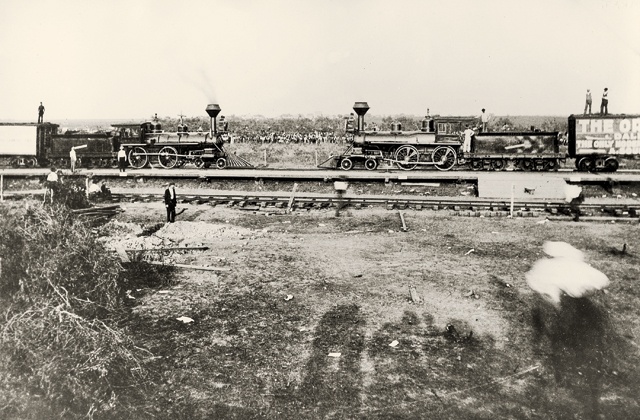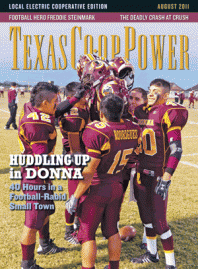On September 15, 1896, two massive steam locomotives raced toward each other at full throttle on a single track 15 miles north of Waco. The trains’ planned rendezvous point was the temporary town of Crush, created for a single day to host a bizarre publicity stunt staged by the Missouri, Kansas and Texas Railroad, commonly known as the Katy.
More than 40,000 people crowded the slopes above the crash site, pushing forward anxiously to get a good view of the collision between the locomotives—each pulling six boxcars. Roaring downhill at estimated speeds of 45 to 60 mph, steam whistles screaming, the trains collided with a shattering boom punctuated by rending timbers and billowing black smoke. By some accounts, the locomotives reared up against each other like battling beasts, and then fell over on their sides. Silence fell for an instant, and then the boilers of both engines simultaneously exploded, launching missiles of metal through the air and into the crowd.
In the blink of an eye, what was supposed to be a safe publicity stunt turned deadly: Three people were killed, including teenager Ernest Darnall, who watched the spectacle from his perch in a mesquite tree and died instantly when a heavy hook on the end of a wrecking chain hit him between the eyes and split his skull. Several dozen people were injured, including those scalded by steam and burned by jagged, hot shrapnel. A flying bolt ripped out the right eye of official event photographer Jervis Deane, who was on a stand less than 100 feet from the track.
Injured spectators sprawled on the ground in pain and bewilderment—they had been assured that the engines’ boilers would not explode.
The train wreck was the brainchild of William George Crush, passenger agent for the Katy, who convinced his superiors that a staged train wreck would generate much-needed publicity for the railroad during a time of national economic downturn. Crush was right. Newspapers from all over wrote about the impending event, and the Katy arranged for 33 excursion trains to pick up onlookers from around the state and deliver them for the price of a $2 round-trip ticket.
Two 35-ton engines (1870s vintage) were chosen as the participants. Old No. 999 was painted bright green and No. 1001 blood red. Each was outfitted with six boxcars plastered with advertising posters. Crush, a friend of showman P.T. Barnum, threw himself into the preparations with theatrical gusto, setting up a restaurant inside a borrowed Ringling Brothers circus tent.
Excitement reached fever pitch around 4 p.m. as the two trains steamed slowly together and touched cowcatchers, the locomotive equivalent of the dueling handshake. Then each engine backed up one mile. The track lay in a shallow valley among three hills, creating a natural amphitheater and affording the shoulder-to-shoulder crowd a fine view. Crews onboard the locomotives had their instructions: Open the throttles all the way, tie the whistle cords down and JUMP. Crush, conspicuous on a prancing white horse, rode back and forth before the crowd, which pressed ever forward, beyond the roped-off safety zone. When all was ready, Crush threw his hat into the air, and the trains began to move.
After the crash and explosion, the crowd momentarily stood stunned as groans and cries from the injured filled the air. Those wounded were collected, some from as far as half a mile away, and treated by doctors who had closed their offices to witness the event. The uninjured rushed forward to snatch souvenirs from the smoking ruins.
Before nightfall, Agent Crush was summarily fired, but it only took a few days for railroad officials to discover that the crash at Crush had accomplished its purpose: Overnight, the story made headlines around the world. Everyone was talking about the Katy, business boomed, and Crush was quietly rehired. Scott Joplin, the great ragtime composer who was rumored to be at the event, wrote a musical tribute called “The Great Crush Collision March” later that year.
Katy officials financially compensated the injured and the families of the deceased. Deane accepted a $10,000 settlement and a lifetime pass on the Katy. A few months after the crash, he put this notice in a Waco newspaper: “Having gotten all the loose screws and other hardware out of my head, am now ready for all photographic business.”
The crash of the locomotives achieved its publicity purpose, but, not surprisingly, no railroad has ever elected to repeat it.
——————–
Martha Deeringer is a frequent contributor.


